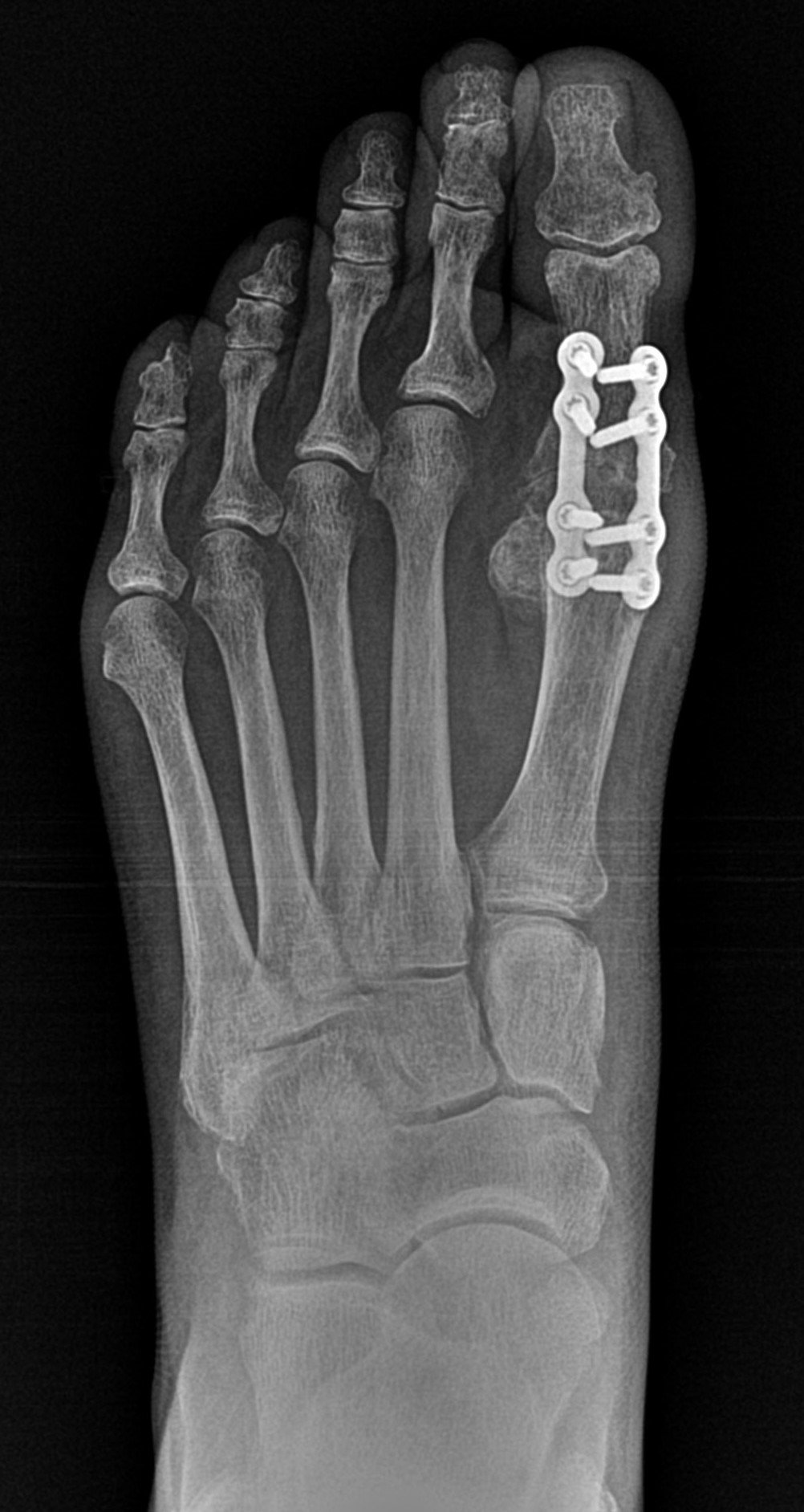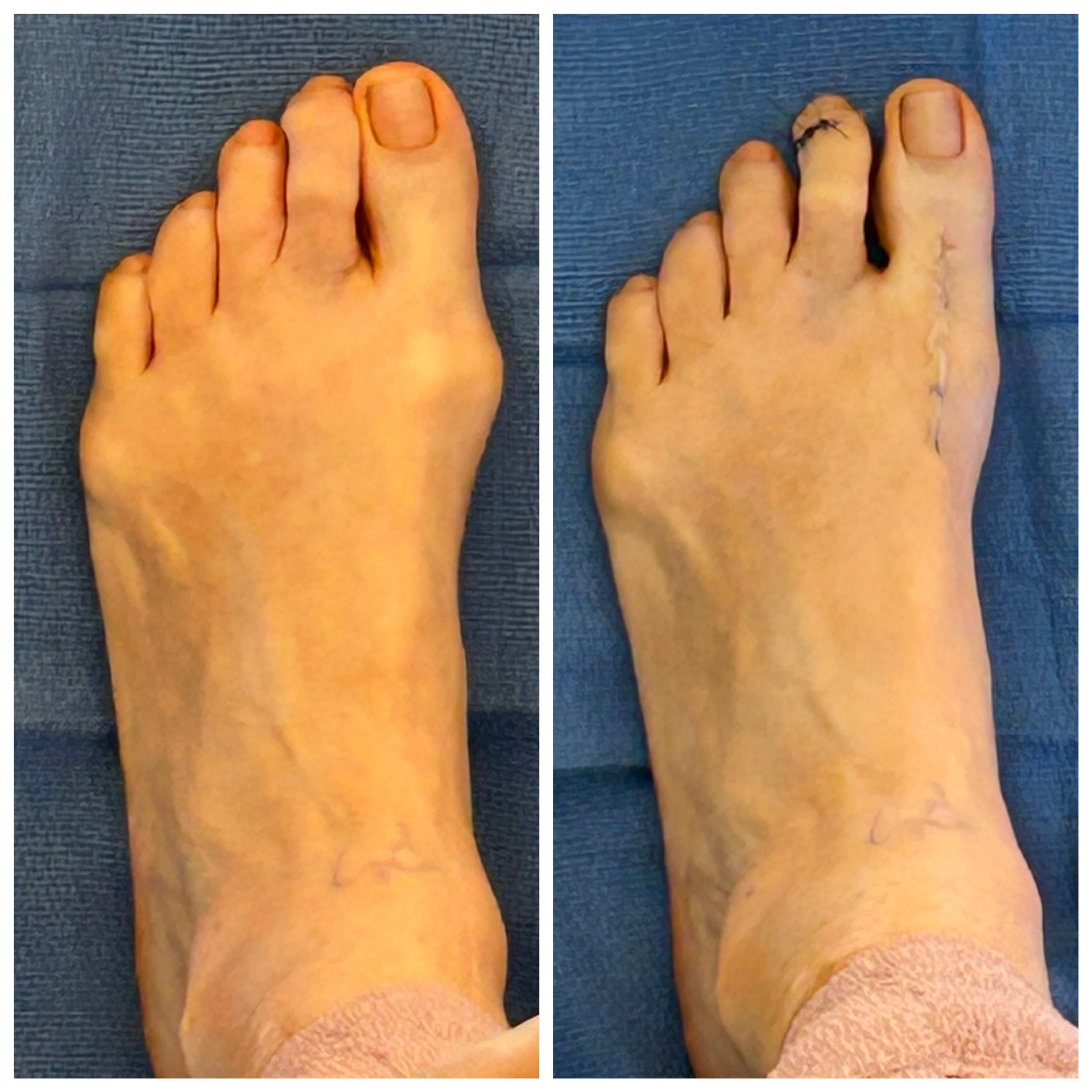Big Toe Joint Pain? What is this pain from and what are the solutions.
Are you having big toe joint pain when you walk or run? Does it hurt to bend, or to do a lunge in the gym.
If motion in your great toe joint occurs you may be suffering from a condition called hallux limitus/hallux rigidus. This is an arthritic condition of the great toe joint. The good news is there are surgical and non-surgical options for treating this painful condition.
What is Hallux Limitus/Rigidus?
The simplest way to describe this condition is an inability of the great toe joint to bend normally. Usually this occurs because of genetic factors (the way mom and dad built you), that results in an abnormal alignment of the great joint. Instead of the toe bone or phalanx gliding easily onto the midtarsal bone, they abruptly jam together.
Painful spur to great toe joint.
Poor motion means that when you were bend at the toe joint during walking, running and especially squatting, the joint jams, causing pain, swelling and eventually arthritis.
Overtime, this rubbing in your joint can causes the loss of smooth cartilage and a bony growth will begin at the top of joint. The spur can hurt simply just touching your shoe. If left untreated pain worsens, and eventually the joint will become so arthritic that you are only left with a surgical option.
Cyst formation noted (arrow) and flattening and narrowing of joint occurs.
How to reduce pain from Hallux Rigidus and prevent worsening of condition?
If this condition is caught early things can be done to improve the joint range of motion, so it doesn’t continue to jam together when bending.
1) Achieving better motion to the joint.
Special pads can that are placed on the bottom of the foot to increase range of motion, or a physician can modify an over the counter insert. If one of these options help custom made orthotics if the best conservative treatment and preventative option to help reduce pain and worsening. Orthotics are simply custom inserts made from a mold of your foot with modifications to help motion of big toe.
2) Pain relief
While padding, inserts or orthotics can improve motion and reduce pain, the best way to quickly reduce pain in a steroid injection performed in office. This takes just a few seconds to perform after numbing skin with cold spray. Pain relief should be immediate as toe becomes numb. Once numbing medication wears off pain might return for a few days but then progressively gets better for most patients.
However, if the condition continues to worsen injections are limited to only three per year and are not recommended three every year as joint damage can occur from injection itself.
3) Surgical repair of painful rubbing joint
For patient suffering with early stage arthritis with a small spur that limits motion from this condition, a procedure called a cheilectomy can be performed. I myself have had this procedure and had many years of relief, but I caught my condition very early.
The cheilectomy surgery procedure removes the bony spur at the top of the first metatarsal head. At the same time, any damage to cartilage is improved through a process called fenestration; basically tiny drill holes are made into the bone where cartilage has been lost in joint. This allows for blood to infiltrate this area and grow a type of scar tissue that acts like a buffer to future rubbing. After this procedure, a little bit of a material called bone wax is applied to the area where spurs cam from to recurrence.
Painful spur formation from jamming of joint.
Post cheilectomy procedure with removed spur, allows for better joint motion with less pain.
After this surgery most patients will still have some pain with bending and are required to wear a custom orthotics. This is exceedingly important if they want to prevent the pain from returning. After this procedure, if you continue to perform activities that cause the big toe joint to bend aggressively, the pain will return and more surgery will be needed. This means avoid burpees, planks, lunges and mountain climbers in the gym.
How to resolve Hallux Limitus/Rigidus problem permanently with Lapiplasty®
If patient have severe damage the joint, or has failed a cheilectomy procedure, the best option is fusion of the great toe joint.
Now you may think that motion of this joint is necessary for normal function however, patients are able to return to normal activity after this procedure. In fact, in my practice, most patients return to pre surgery activity and often start doing more activities because pain is no longer restrictive to trying new things.
The only advice is to not do activities like lunges repeatedly as they will be uncomfortable to perform, or wear higher than a 2 inch heal again for any prolonged time.
Treace Lapiplasty® for big toe joint fusion
In my practice, I utilize the Treace medical Lapiplasty® system to fuse the great toe joint. This system solves many of the problems of previous implants that were used for this procedure, both technically and postoperative for the patient.
Traditional great toe joint fusion surgeries used two small screws or wires replaced across the joint. Some surgeons still prefer this technique, most patients do not. With this option, patients were not allowed to walk for anywhere from 4 to 8 weeks on the foot, meaning you were placed in a cast or non-weightbearing in a tall walking boot.
Overtime, advancements allowed for placement of a single solitary plate over the top of the joint. These still exist to this day, however placing one solitary plate over the joint does not provide intrinsic stability. In my experience, most surgeons including myself, when I was used single plate technology, placed the patient in a cast for 2 to 4 weeks before allowing the walk.
The Lapiplasty® system has improved the fusion procedure procedure because it uses two smaller plates that when placed approximately 90° apart on the joint creates from stability, allowing patients to bear weight on their foot the day of surgery and throughout the recovery.
Severe joint space narrowing to great toe joint
Fusion of great toe joint with Lapiplasty® plates.
Another advantage is the equipment provided by Treace medical with this system allows surgeons to reduce deformity like bunions at the same time, helping patients that have had chronic bunions that led to arthritis.
Surgical recovery with Treace Lapiplasty® Great Toe Joint Fusion
The surgery itself is day surgery, allowing the patient to arrive approximately one hour before surgery, the procedure is approximately one hour under sedation so you don’t feel pain during the procedure, and then about one hour in the post-op recovery unit. The foot will be numbed up(anesthetized) while you are sleeping to prevent pain after and on average will remain numb for about eight hours.
As the patient, you will be provided with several pain medication‘s in my practice, not just narcotic with the intent to reduce pain and get you off narcotics as soon as possible. Patients will be expected to elevate their foot, ice frequently and take the pain pills as instructed. Patients will have a tall boot in place to protect and help them to walk. The boot is required for short distances in home, 10 to 15 minutes and hour you can be on the foot, as needed for bathroom break. Basically, couch to kitchen, bed to bathroom.
After three days, patient will return for follow up with me in my office. X-rays will be taken to confirm everything is healing appropriately followed by a return two weeks after surgery for incision check.T he majority patients do not require suture removal as these incisions can be closed cosmetically.
Incision over great toe joint closed with sutures under skin.
No physical therapy is required during recovery for this procedure because once the joint is fused no additional therapy is required. The patient wears a boot for a period of six weeks from the date of surgery with limited activity, but by week four they are basically walking normally, just slowed down by the boot. Often patients will use a knee scooter for long distances outside the home.
At week six typically x-rays are taken to identify appropriate healing. Then patients transition into an athletic style shoe that they wear for additional six weeks.
After six weeks in atheltic shoes patients return to shoes that they feel comfortable in as long as they stay lower than a 2 inch heel and return to full impact exercise at four weeks after this (4 months post-op ).
For those patient wanting to be active and exercise throughout recovery you definitely can with some restrictions. The activity instructions article is linked below, but any exercise that can be done as long as you’re not standing on your feet for prolong periods of time.
https://www.3dbuniondoc.com/blog/vg43ac2kwtvynejyds3f68h3qdpv7y
With any surgery there are risks, here are a few we must consider. In my practice there is a small risk of delayed healing of the great joint or failure to fuse, which would require additional surgery, but this is very rare with this new instrumentation. Obviously with any surgery risks like infection and swelling can occur, but also are very rare to see infection, and swelling is a normal normal process that is taken care of by icing elevating and following appropriate protocols provided by your physician.
Please see the links just below at end of article if you would like to watch the procedure. Other links are also available with information that will help you recover. While this procedure is different than the traditional Lapiplasty procedure which is designed to correct bunion deformity in the mid foot, the recovery is essentially the same with your omission of need for range of motion and physical therapy after surgery.
Most importantly if you suffer from great toe joint pain, there are conservative and surgical options, but if surgery is your last option for relief the Lapiplasty® system has an excellent track record for getting you back on your feet quickly pain free.
Lapiplasty® first MTP fusion surgical video
How soon can I walk after Hallux Limitus surgery with Lapiplasty®?
Week by week recovery instructions after bunion correction or hallux limitus fusion








